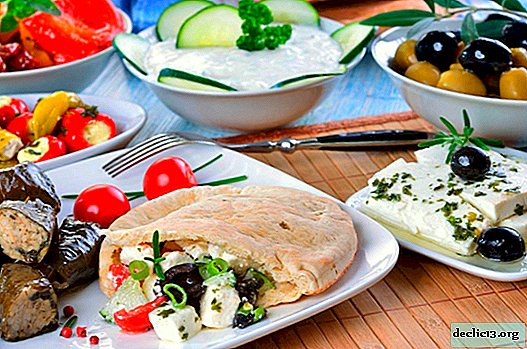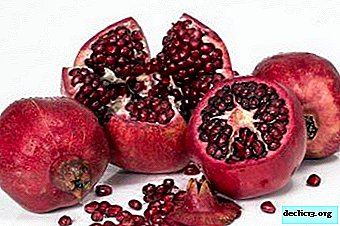Greek cuisine - which dishes are worth trying?
The impression of the country will not be complete if you do not try national cuisine at local establishments during your trip, especially when it comes to Greece. Greeks love, and most importantly, know how to cook, turning the national Greek dishes into a work of art.

Features of national cuisine
National dishes of Greek cuisine are characterized by a multifaceted game of tastes and benefits. Many nutritionists recommend to adhere to the Mediterranean diet based on the principles of Greek cuisine to normalize weight.
The benefits of Greek cuisine are due to simple but important factors:

- Use of healthy products - fresh vegetables, herbs, home-made cheeses, seafood, fruits;
- Greeks do not abuse junk food;
- the most popular, traditional product is olive oil, which is added to many dishes of national cuisine, its benefits have been known for millennia;
- national dishes are seasoned with lemon juice instead of salt, citrus fruits are added to main dishes (meat and fish), marinades, desserts;
- Greeks often consume a lot of dairy products - yogurt, goat milk, feta and feta cheese.
The main feature of national cuisine is natural, environmentally friendly products, most are grown and produced in the country.
It is interesting! National Greek cuisine is a specific lifestyle. According to statistics, Greeks are less likely to suffer from cardiac and oncological pathologies, and obesity. The first book on Greek food culture was written in 330 BC.
First meal
 Fax
FaxThe first dishes are not popular in national cuisine, as a rule, they cook mashed soups from vegetables.
But still in Greece you need to try soups:
- "Fasolada" - a traditional bean soup;
- "Fax" is a lentil stew, complemented by salted fish, cheese (most often feta cheese), olives and red onions. These soups are offered in hot weather.
In winter, more rich and hearty soups appear in the restaurant menu:
- "Avgolemono" - soup with rice groats on chicken broth with beaten egg and lemon juice;
- "Vrasto" is a national beef soup.
Greek snacks
Traditionally, every meal begins with snacks that stimulate appetite. They are served in small diameter plates. Snack dishes that the Greeks love themselves and recommend to tourists to try:
 Dolmadakya
Dolmadakya- "Zadziki" is both an appetizer and a sauce made from yogurt, fresh cucumbers, olive oil, fragrant garlic;
- "Dolmadakya" - an analogue of traditional cabbage rolls and dolma, an appetizer of rice, minced meat wrapped in grape leaves;
- "Kalamarakiya" - squid fried to a crust;
- "Taramasalata" - a national dish of smoked cod caviar, olives, herbs, lemon and vegetable oil;
- "Tirokafteri" - a traditional soft cheese snack and pepper (hot varieties).
Salads
In the national cuisine of Greece there are two types of salads:
 Melizanosalata
Melizanosalata- hot - with baked vegetables;
- cold - with fresh vegetables.
Among the hot salads, the following are popular.
- Broccola is a traditional broccoli dish.
- "Pandzari" - beetroot salad.
- "Melizanosalata" - a mixture of baked eggplant, vegetable oil, spices, lemon and allspice garlic. Sometimes yogurt, tomatoes are added to the dish, seasoned with green onions. Nutritionists call this dish impeccable in terms of the principles of proper nutrition, and gourmets rightly consider this combination of products to be ideal in taste.
 Greek salad
Greek saladThe composition of the national cold salads includes fresh vegetables, spice mixtures, a variety of cheeses, olive oil and lemon juice. They are traditionally served with wine or grape vinegar.
- Hortu is a traditional dish of dandelions, the main ingredient is radikyu.
- "Choriatics" or village salad - in our area, the dish is better known as "Greek salad". The composition includes tomatoes, cucumbers, sweet peppers, onions, olives, aromatic seasonings and olive oil, complement feta cheese. You will probably be interested to try the Greek salad in his homeland.
- "Lahano" - a salad of their white cabbage, carrots, root and celery leaves, some housewives supplement the salad with sweet pepper.
 Dakos
DakosIn many ways, Italian cuisine influenced the food culture in the country. This effect is expressed in the use of products common in Italy, for example, ruccola. In some regions of Greece, they offer to try a salad of ruccola leaves - Roca. A popular recipe is sun-dried tomatoes, ruccola, Parmigiano Reggiano cheese.
In Crete, they love the traditional Dakos salad made from special, large crackers; The mixture is seasoned with olive oil mixed with oregano. Sometimes dakos crackers are replaced with small dakakya crackers.
Greek main dishes
Traditional Greek dishes from the main group are prepared from meat, fish and seafood. There is plenty to choose from and things to try.
Meat dishes.
 "Brizoles"
"Brizoles"The culture of national Greek cuisine is based on one fundamental rule - no need to complicate. A good dish, according to the Greeks, is prepared as quickly and easily as possible, which is why they prefer to simply bake meat in any convenient way. Different meat is eaten, but if you are traveling in mountainous areas, you should try baked game or wild boar meat. Traditional Greek Meat Dishes:
- "Brizoles" - juicy, flavorful meat on the bone;
- "Souvlaki" - compact kebabs;
- "Kondosuvli" - an analogue of our traditional barbecue;
- "Paidakya" - traditional baked ribs (most often lamb);
- "Gyros" - a dish in a tortilla, similar to dener kebab or shawarma, but excellent in that it necessarily contains french fries.
- Kokoretsi. True gourmets will surely want to try this dish, because how appetizing it sounds: the internal organs of the lamb, wrapped in intestines, and baked in the oven.
 "Beefs"
"Beefs""Bifteki" - ordinary chopped cutlets of different diameters, seasoned with aromatic herbs, cheese, various vegetables.
The national traditions of Greek cuisine are based on the culture of many peoples, for many decades they were formed under the influence of the Turkish yoke:
- "Suzukakya" - traditional cutlets densely seasoned with spices;
- "Kebabs" - masterfully prepared in the northern regions, the Turkish diaspora settled there.
First of all, this category includes home-made meat or game in clay pots with vegetables. The most common name for Kleftiko.
 "Arnie Lemonato"
"Arnie Lemonato"Treats of national Greek cuisine to try:
- "Kuneli" - rabbit stew stewed with vegetables;
- "Arnie Lemonato" - lamb cooked with lemon marinade;
- Coconisto - beef with tomato marinade;
- Musaka is a popular traditional dish in the Balkans. It is prepared from eggplant, minced meat, tomatoes, potatoes, cheese, onions, then baked with Bechamel sauce and cheese;
- "Pastizio" - puff pastry casserole, minced meat, traditional white marinade.
On a note! Garnish served with meat - rice, vegetables.
Fish dishes
Each tourist to the question - what to try in Greece with food, will definitely answer - fish and, of course, seafood. Indigenous Greeks are honored with sea gifts, because the state is located on the coast of the sea.

Large fish baked on charcoal or grill, seasoned with vegetable oil and lemon juice.
Small fish - sea tongue, red mullet, sultanka fried. Also, cod, stingray, swordfish, shark (small, Mediterranean) are most often fried.
Certain fish are used exclusively in the preparation of fish soup. Fish is served separately with marinade made from vegetable oil and lemon, and the broth is served separately.
Lake varieties of fish - trout, sturgeon or salmon - it is better to try in the central regions or in Macedonia.
Important! The traditional approach to cooking is the impeccable freshness of the products. The price is determined by the place of prey - local fish is more expensive than imported. Fish menu in restaurants is more expensive than meat.
Seafood is presented in a separate section on the menu.
 Baked octopus
Baked octopusPopular dishes:
- octopuses: baked or boiled;
- squid: traditional baked - "Kalamaria Tiganita", fried with cheese filling - "Kalamaria Yemista me Tiri";
- cuttlefish stewed with spinach leaves;
- shrimp: fried or stewed in tomato and cheese marinade;
- traditional mussels steamed or in tomato and cheese marinade.
Helpful information! Crown national treat in Greek cuisine - spiny lobster with pasta - "Pasta me Astako".
The gifts of the seas are given special attention, culinary masterpieces are prepared from them, which will easily charm the discerning gourmet. If you want to try something special, pay attention to the shrimp dish cooked in tomato sauce and seasoned with feta cheese, or the octopus dish in sweet wine, seasoned with spices.
Dessert
Traditional sweet Greek dishes are, first of all, Turkish heritage. By the way, the tradition of drinking coffee made in Turk also remained from the Ottoman Empire.
 "Lucumadez"
"Lucumadez"Resting on the Mediterranean coast, be sure to please yourself with original desserts:
- "Lukumades" - balls made from dough, seasoned with spices, sprinkled with honey, sprinkled with icing sugar;
- “Baklava” - a traditional pie stuffed with fruit syrup, chopped nuts, dessert, as a rule, is prepared from 33 layers (a symbol of the age of Christ);
- "Curabiedes" - cookies made from shortcrust pastry and almonds;
- "Rizogalo" - a pudding of rice, dried fruits, nuts, seasoned with cinnamon;
- Halvas - halva, which is made from semolina.
Greek sauces
If you study the dishes of Greece that you need to try while traveling, be sure to pay attention to sauces. The Greeks are well versed in them and prepare them for almost every dish. Features of traditional Greek sauces:

- only natural ingredients;
- no complicated recipes;
- maximum benefit.
The main principle of proper sauce is that it must delicately emphasize the taste and aroma of the main treat.
Sauce ingredients should be as versatile as possible and combined with fish, seafood, meat, vegetables. Most often in the cooking process use:
 Avgolemono
Avgolemono- natural yogurt;
- vegetable (olive) oil;
- lemon juice;
- special, Greek garlic.
The classic sauce is Avgolemono. It is served with main dishes and salads, used in the preparation of soups. It is cooked in just a few minutes - a mixture of eggs and lemon juice is diluted with broth. Proportions are selected individually depending on the desired density of the sauce. Marinade gives the main dish a slight sourness.
The secret of cooking! You can not bring the marinade to a boil, because the protein will curl.
 "Scotthalia"
"Scotthalia"For seafood, marinade is prepared from mustard, vegetable oil, lemon juice, a mixture of dried herbs. In some regions, honey is added to this mixture; it gives the dish a soft, uniform texture. For fish, and as a salad dressing, a sauce is prepared from only two components - lemon juice and olive oil.
Main dishes are served with Scotthalia sauce made from allspice garlic, almonds and vegetable oil. Sometimes bread crumbs and chopped potatoes are added to the sauce. So you get a satisfying snack.
The secret of cooking! To smooth the vigorous taste of garlic, it is pre-baked.
Original Fava sauce - it is made from mashed beans or lentils, seasoned with olive oil, lemon juice, natural yogurt and herbs (usually parsley).
National Products
 Feta
FetaGreek cheese deserves special mention. The country produces more than 60 varieties of cheese, each of which is served as a snack or main dish, used to prepare other dishes. During your stay in Greece we recommend you try the following cheeses:
- "Feta" - white cheese, a fairly dense consistency, prepared from sheep's milk (less often from goat milk).
- "Gravera" - a cheese with a sweet taste, solid texture, prepared from sheep's milk.
- "Manuri" - sheep’s cheese, has a soft, delicate texture, has a high calorie content.
- "Casseri" - cheese made from a mixture of sheep and goat milk, white with a slight yellowish tinge.
- Kefalotiri is a piquant cheese with a brackish flavor and a solid, porous structure.

Another traditional dish is olive oil. Here they sell it at every grocery store. Sometimes you can try a product before buying. The oil is presented in its pure form or with the addition of spices, aromatic herbs.
National drinks
OuzoThe most famous Greek alcoholic drink is ouzo. It is worth a try first. It is prepared narrowly by distillation of alcohol with the addition of anise, a bouquet of spices (most often cinnamon, nutmeg and cloves). There are many beverage manufacturers in Greece, therefore the composition and percentage of alcohol content is different - from 20% to 40%.
They use ouzo with fish and seafood dishes, and serve it in tall, narrow glasses. In grocery stores, drinks are sold in bottles of different volumes, the minimum cost is 3 euros.
Tsipuro and Crayfish
Tsipuro (tsipuro) and crayfish are alcoholic drinks with an alcohol content of 37% to 47%, reminiscent of moonshine. The main difference between them is the presence of anise - it is present in tsipuro, and there is no spice in crayfish.
Tsipuro is served chilled, in a decanter with a high, narrow neck. Drink from small glasses, in one gulp. As a rule, Tsipuro is ordered by the Greeks of the older generation, the younger generation prefers other drinks. The cost of one bottle varies from 3 to 4 euros.
Rakomelo
This is an alcoholic drink, which consists of two components - honey and crayfish (not those that are found in the river, but the one described above). Sometimes add cinnamon and cloves. The drink is most often prepared in the cold season, because you need to drink it hot. Some Greeks use racomelo as a medicine for colds.
Rakomelo can be bought at any supermarket, but it is better to make a drink yourself - buy crayfish and honey. The process will take several minutes, and the taste is much better than the store product. Pour the crayfish into a Turk, heat, add honey to taste, remove from heat before boiling. The drink is ready, now you can try it!
Mastic
Greek liquor, a distinctive feature is the presence of mastic - resin, which is obtained from an evergreen shrub. Mastic in Greece is used to prepare many dishes in cosmetology.
Liquor is served as an aperitif and after meals for better digestion. The taste of mastic is original and memorable - sweet with a light fruity-coniferous aroma. The cost of one bottle is about 10 euros.
CoffeeThe most popular drink in Greece is coffee. It seems that they drink it constantly - hot, cold, with and without froth, with milk or cream, with the addition of various spices. If a person orders tea instead of coffee, the Greeks will definitely think that he has health problems.
If you want to fully understand what national Greek dishes are, try them not at the hotel, but at local taverns and restaurants. This is the only way to experience the taste of real Greece.

















